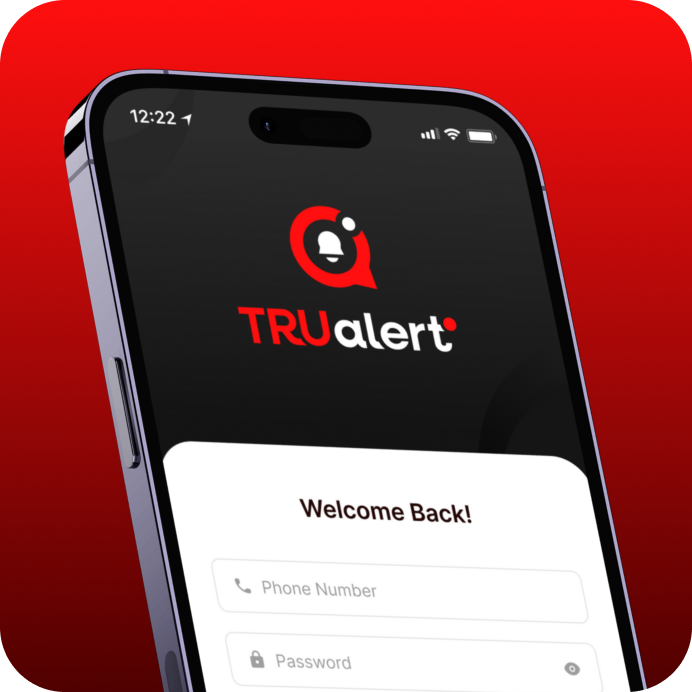Sexual assault is a critical issue that affects students in various educational settings, from high schools to universities. Creating a safe environment for students requires comprehensive prevention strategies and swift, effective responses.
This blog will outline key prevention measures and response protocols, as well as introduce the TRUalert App, which ensures timely support and enhances campus safety.
Numbers Don’t Lie: The Prevalence of Sexual Assault on College Campuses
Understanding the scope of sexual assault on college campuses is crucial for developing effective prevention strategies. Statistics consistently show alarming rates of victimization among students.
According to the National Institute of Justice, studies reveal that 1 in 5 women and 1 in 16 men are sexually assaulted during their time in college, with many cases going unreported (Womens Health Gov). Moreover, unwanted sexual contact and sexual coercion are the most common forms of victimization, with alcohol often playing a significant role in these incidents (National Institute of Justice).
Key Statistics on Campus Sexual Assault
- 1 in 5 women will experience sexual assault during their time in college (Womens Health Gov).
- 15% of young women experienced incapacitated rape, typically involving alcohol or drugs (Womens Health Gov).
- Only 20% of sexual assault victims report the crime to authorities (National Institute of Justice).
- 1 in 3 rape survivors who remain on campus face academic difficulties, and many contemplate leaving school (Womens Health Gov, National Institute of Justice).
These figures highlight the critical need for action and resources on campuses to protect students.
Moving Toward Solutions
The high rates of sexual assault among students demand comprehensive solutions, including better prevention strategies, awareness campaigns, and immediate response mechanisms. Understanding prevention strategies will give us effective ways to reduce the risk of these crimes and safeguard student communities.
Understanding the Importance of Prevention Strategies
Preventing sexual assault begins with education and awareness. Schools and universities must implement robust programs that emphasize consent, respectful behavior, and the consequences of sexual violence. These programs should be mandatory for students, staff, and faculty, ensuring everyone understands their role in creating a safe environment. By promoting a culture of respect and vigilance, institutions can significantly reduce the likelihood of sexual violence on campus.
Empower your campus experience by downloading TRUalert—ensuring swift responses to emergencies and immediate access to safety resources, no matter where you are.
Building a Culture of Consent
A fundamental aspect of preventing sexual assault is fostering a culture of consent. Educational institutions must integrate consent education into their curricula and campus events, teaching students how to navigate boundaries respectfully. Faculty and staff play a crucial role by modeling respectful behavior and holding students accountable for their actions. By incorporating consent-focused education, schools can build an environment where everyone feels safe and respected.
Effective Response Strategies to Sexual Assault
In the unfortunate event of sexual assault, a swift and supportive response is essential. Schools must have clear, accessible reporting mechanisms for students to disclose incidents without fear of retaliation. Universities and colleges are legally obligated to comply with Title IX, ensuring that survivors are supported and perpetrators are held accountable. Additionally, TRUalert App offers a vital tool for students and campus security, allowing them to report emergencies and receive immediate assistance.
Immediate Actions to Take if You Are Helping a Victim of Sexual Assault
Witnessing or being in a position to help someone who has experienced sexual assault is a critical moment that requires compassion and immediate action. Your response can significantly impact the survivor’s safety, well-being, and access to support. Below are five key steps to take when you are faced with this situation.
- Ensure Immediate Safety
Ensure the survivor is in a safe space away from the perpetrator. Move them to a private, secure location, such as a campus office or safe room, to prevent further harm. - Listen and Offer Support
Listen without judgment. Allow the survivor to speak at their own pace and offer reassurance, emphasizing that they are believed and supported. - Encourage Medical Attention
Advise the survivor to seek medical attention immediately, even if there are no visible injuries. A medical professional can provide care and collect forensic evidence, which may be important if the survivor chooses to report the assault later. - Respect Their Choices
Allow the survivor to make their own decisions regarding reporting and next steps. While encouraging them to report the assault is important, respect their autonomy and do not pressure them into any action they are not ready for. - Contact Appropriate Authorities
Encourage the survivor to contact campus security, law enforcement, or sexual assault support services. Offer to help make these calls or accompany them, but allow the survivor to take the lead on their decisions.
If you find yourself or someone else in a sexual assault situation, it’s crucial to know the numbers you can call for immediate help. Here are some important contacts:
- National Sexual Assault Hotline: Call 1-800-656-HOPE (4673) for confidential support 24/7. You can also access online chat support through RAINN’s website.
- National Domestic Violence Hotline: For assistance with domestic violence-related incidents, call 1-800-799-SAFE (7233). (National Sexual Violence Resource Center)
- Text-to-911: In some areas, if you are unable to call, texting 911 is an option for emergencies.
- DoD Safe Helpline: If you are a member of the U.S. military or a family member, you can call 877-995-524 (RAINN).
- National Street Harassment Hotline: For support on street harassment, call 855-897-5910 (RAINN).
These hotlines and services are available to support those in need, whether you’re directly involved or a concerned bystander. The information is accessible around the clock to ensure the safety and well-being of victims and offer resources to help with recovery.
Moving Toward Action
Responding effectively in the aftermath of a sexual assault is vital for the survivor’s recovery and safety. By following these steps, you can provide crucial support and help them access the resources they need to heal and move forward.
Protect yourself and your peers—get the TRUalert App for instant access to security services and fast emergency response when every second counts.
RELATED CONTENTS:
Campus Safety: Must-Have Apps for College Students
Everyday Safety Tips: Simple Strategies to Stay Safe in Any Situation
Beyond Pepper Spray: Proactive Strategies for Personal Safety
Utilizing Technology for Enhanced Campus Safety
Technology plays a crucial role in enhancing campus safety, especially in emergencies like sexual assault. The TRUalert App, with its real-time Safety Pulse alerts and SMS-based emergency dispatch through Noonlight, ensures students are always connected to on-the-ground assistance.
Whether on campus or off, students can use TRUalert to discreetly request help, report suspicious activities, and feel secure knowing trained emergency responders are on standby. The app’s ability to deliver fast response times is a game-changer in preventing harm and ensuring quick intervention.
We designed TRUalert with features to give you immediate, reliable security solutions with just a tap:
- Emergency Button: Instantly sends an SMS alert to Noonlight’s 24/7 dispatch service. Whether you’re alone, facing a threat, or feeling unsafe, help is available with one tap.
- Direct Communication: Communicate with responders via SMS, providing critical details for a faster, more accurate response.
- Safety Pulse: Share and receive real-time updates about safety incidents, creating a community-driven approach to campus security.
- Service Features and Follow-Up Reports: After each alert, TRUalert generates detailed reports for police, insurance, or academic documentation. User privacy is prioritized, with explicit consent required before sharing any incident information.
Download the TRUalert App today to ensure you’re always just a tap away from immediate safety, empowering students with real-time security alerts and emergency response.
Comprehensive Support Systems for Survivors
Support for students who experience sexual assault should not end with a report. Colleges and universities need to provide ongoing resources, including counseling, legal support, and academic accommodations. Creating an inclusive and supportive environment for survivors is essential for their healing and academic success.
Take Action Now: Protect Your Campus Community from Sexual Assault with TRUalert’s Proven Solutions
Protecting students from sexual assault requires a combination of proactive prevention and effective response strategies. Implementing comprehensive education programs, fostering a culture of consent, and utilizing technology like the TRUalert App are essential steps toward ensuring student safety. We encourage educational institutions to prioritize these strategies and implement tools that make campus safety a top priority.
If you want to ensure a safer environment for your school community, download the app today to learn how TRUalert can enhance your campus safety measures.




